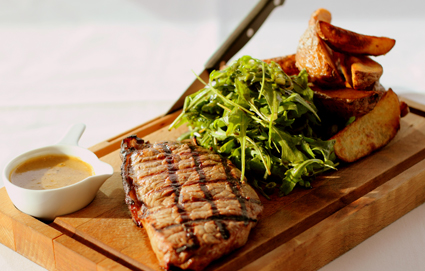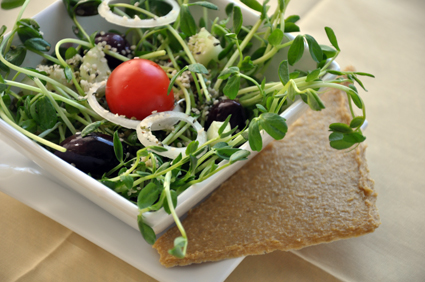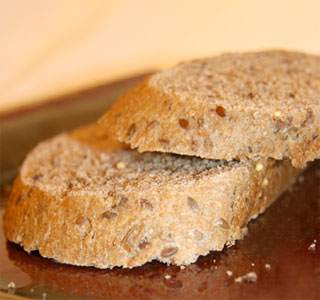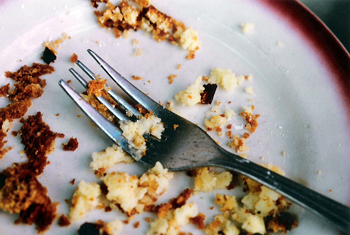When looking for the healthiest choices at a local business or restaurant here are some tips:
1. Choose lean protein such as…
- Chicken
- Beans/legumes
- Turkey
- Game meat
- Lean cuts of beef or pork such as the tenderloin
- Nuts/seeds
- Soy/Tofu
- But also try to incorporate fatty fish such as salmon, trout, or tuna at least twice a week to reap heart health benefits from their Omega 3 fatty acid.

- Avoid added fat via frying, breading, or other high calorie cooking methods
- Grilling, baking, or broiling uses heat treatment and usually spices or a light marinade for flavor, not oils, butter, or grease.
- If you like salads because of the cheese, bacon, croutons, fried chicken, or loads of ranch dressing, then choosing another entrée will most likely be a better option.
- The veggies, greens, and legumes topped with a lean meat are what can make a salad low calorie, high protein, and a great source of nutrition. When it is loaded with high fat high calorie ingredients, the salad itself becomes high fat and high calorie.

4. Ask for your sauces, dressings, or condiments on the side.
- These are often the source of excess calories and can transform an otherwise healthy option into a poor nutrition choice.
- Choose sides such as mustards for sandwiches and vinaigrettes or lower fat dressings for salads.
- Try flavoring with just lemon juice as well.
- If you absolutely cannot skip out on a certain dressing or condiment you love, ask for it on the side and apply it yourself. Restaurants and servers tend to be more generous with their portions.
5. If you have a big appetite start your meal with a broth based soup.
- Skip the fried onion rings or calamari and cut a significant amount of calories and fat out of your meal!
- Choose broth low calorie based soups such as chicken noodle, tortilla soup, or vegetable beef. These can fill you up and help control food consumption without cutting out any of the actual eating.
- Avoid creamy or cheesy soups as these are typically high in fat, saturated fat, cholesterol and high in calories.
- Be wary of sodium content though, as soups are usually salty.
- If you don’t want to compromise the creamy texture try a blended vegetable soup such as butternut squash soup. If you are at home this can be easily made, but if you are out to eat be sure to ask the preparation method as they may add unnecessary cream to the soup.
- You can bring a lot of flavor to the table without the negative effects of a high sodium diet. (In fact, some herbs, spices, or other flavorings may be linked to health benefits such as reduced risk of cardiovascular disease and suppressed appetite from garlic and the capsaicin in chili powder, respectively.)
- This will not only enhance the nutritional value of your meal, but it will also keep you feeling fuller longer due to its fiber content which causes things to pass more slowly through your gastrointestinal tract.

8. Be smart when choosing your sides.
- Pick steamed veggies over French fries, brown rice over white and black beans instead of refried.
- This can be the deal breaker for whether or not a meal is going to be a belt buster or keep you on track with your diet.
- If you must have your fries or fully loaded baked potato, eat small amounts to satisfy your craving, but focus on the entrée to fill you up.
- It takes about 15 minutes for your mind to register the feeling of fullness… this is why so many people are able to eat and eat and not feel it…that is until 15 minutes later when they feel like they are going to explode if they eat another bite!
- Use smaller utensils, plates, bowls, cups, etc so it takes longer to eat.
- Also sip water throughout your meal and enjoy a conversation to delay the rate of eating.

10. Drink up!
- Choose calorie free beverages such as water
- A lot of times hunger is confused for thirst as the centers for both are in close proximity to one another in the brain.
- Drinking can also bring a feeling of fullness which can promote you to stop eating earlier.
- Avoid calorie laden beverages such as soda, juice, or sports drinks as your body does not register these beverages any differently than calorie free drinks. So if you consume a caloric beverage you won’t feel any fuller than if you drank water, yet it will add on a significant amount of calories.
What other tips work for you?



